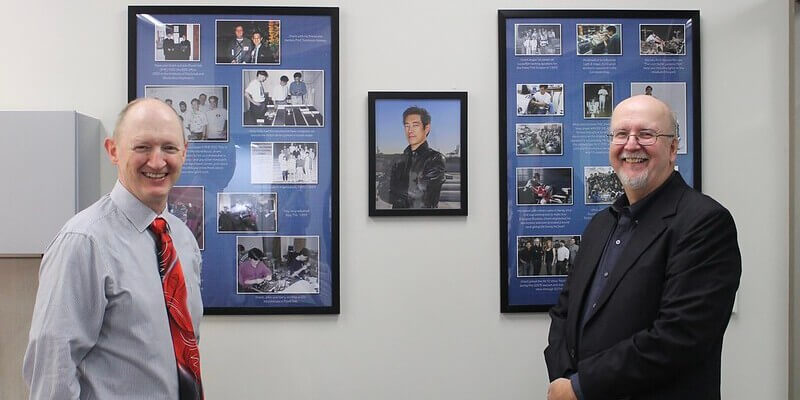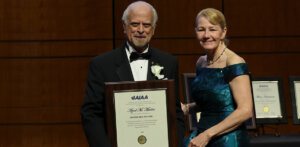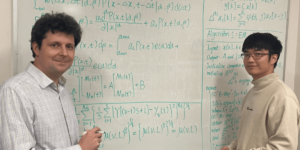
Wade Bick (left) and Don Bies (right) at the recently opened Grant Imahara Study Lounge. Photo credit: Ben Paul.
During his ten years as a MythBuster, Grant Imahara inspired millions. His passion for building and making shone through his work, which was delivered with a compassionate and genuine desire to uplift others.
Electronic effects he made with the Industrial Light Studio were featured in classic movies such as The Lost World: Jurassic Park, the Matrix sequels, and Terminator 3: Rise of the Machines. He created some of the most iconic robotic characters in modern history; he is perhaps most well-known for updating the electronics on R2-D2 for the Star Wars sequels.
After his passing in 2020, Imahara’s family and friends established the Grant Imahara STEAM Foundation to carry on his legacy by inspiring emerging talent and empowering underserved youth.
Imahara graduated with a Bachelor of Science in electrical engineering from USC Viterbi in 1993. In his name, the Foundation has partnered with his alma mater to foster opportunities for today’s engineering students.
A Space for Innovation
October 15, 2021 marked the grand opening of the Grant Imahara Study Lounge. Located in the Ming Hsieh Institute in the Electrical Engineering Building, the lounge is designed to foster the same kind of creation and innovation that marked Imahara’s undergraduate years at USC.
Grant’s graciousness, work and compassion were well known to everyone. It has been a privilege to have him as our alumnus and to be able to celebrate his impactful legacy.
Dean Yannis Yortsos
“When we were ideating spaces for this honor, we wanted a place that would reflect Grant’s experiences here,” said Shrikanth Narayanan, Director of the Ming Hsieh Institute. “We wanted a space that would be visible and inspirational for young future engineers.”
At the ribbon cutting ceremony on October 15, 2021, Wade Bick, Imahara’s friend and peer from his undergraduate years, reminisced about searching for places to study on campus together.
“Having a study lounge for engineering students dedicated in Grant’s name feels like the perfect way to honor his memory,” said Bick.
Grant’s mother, Carolyn Imahara, cut the celebratory ribbon to officially open the lounge.
“I am filled with pride and so honored that you are dedicating the study lounge in Grant’s memory,” she said. “I am thankful to all of the donors who generously gave to the Viterbi K-12 STEM Center, making today’s dedication possible.”
A Day of Making
On October 23, 2021, the K-12 STEM Center celebrated Grant’s birthday by doing what Grant loved—lifting up and encouraging young minds.
Current undergraduates from the USC Makers, a robotics-focused student organization, hosted a Mini Maker Faire with high schoolers from various local schools. During the virtual event, USC students showed off the projects they have done, and fielded questions from excited young future makers.
One member of the club, Aidan Leitch, showed off a few personal projects including a robotic hand and a crawling robot made of soft rubber. He recalled meeting Imahara at the 2016 World Maker Faire in New York City.

Aidan Leitch shows off his soft robotics projects.
“Grant knew that making is more than just engineering or technology; it’s an art form,” said Leitch. “I hope that showcasing USC Makers’ projects inspires young folks to explore the art of making.”
Members of USC Makers were also invited to tour Fonco Studios, where Imahara built animatronics and robots.
“It was interesting to learn about how Grant’s interest in building things started as a child, from putting together Legos to taking electronics apart with a screwdriver,” says Baran Cinbis, Director of Outreach at USC Makers. “That’s exactly how Makers as club started—a couple of students who loved to take things apart and put them back together again.”
“Grant’s work eventually evolved into making full scale production props and animatronics for films, and even that’s similar to what we like to do,” elaborates Cinbis, a junior studying electrical and computer engineering. “A lot of our products are also inspired by films, where we try to recreate the robots from certain movies.”
Continuing the Legacy
Generous donations to the Viterbi K-12 STEM Center through the Grant Imahara STEAM Foundation have enabled them to continue their Computer Science Equity Initiative through 2021 and beyond.
The K-12 Center’s programs have brought STEM to underserved communities in Los Angeles for over fifty years. From their annual Computer Science Education Week in December to regularly offered computer science training for teachers, the Center has striven to bridge the gap for students in the local community.
“The CS Equity Initiative combines all of our programs into one strategy to build a comprehensive computer science pipeline in the communities we serve,” says Sarah Thomas, Assistant Director of the K-12 STEM Center.
The new funding will directly help the Center expand its teacher outreach initiatives, increasing the breadth of courses offered. It also helps the center hire student workers to coordinate events and add extra incentives to keep program participants excited.
“It is clear to me how much Grant encouraged complete strangers to pursue their interests, and how he went above and beyond to support them,” says Thomas.
“That was his life’s legacy, and it is an honor that we’re able to continue his work.”
Published on November 18th, 2021
Last updated on May 16th, 2024













